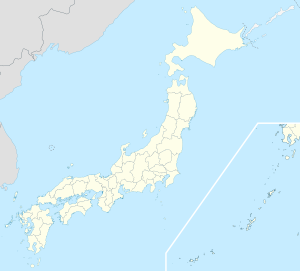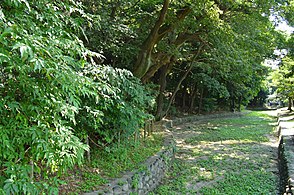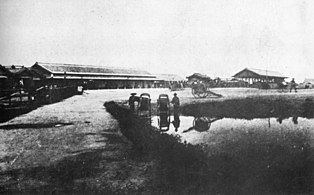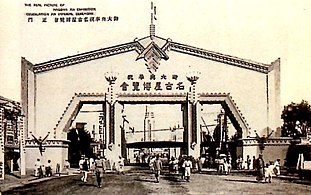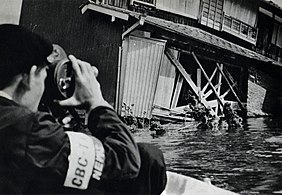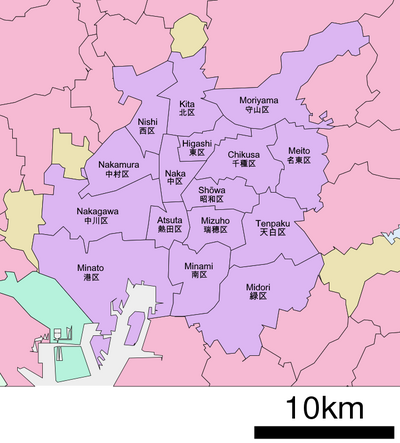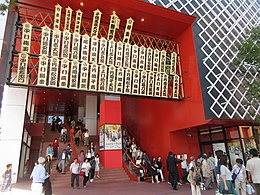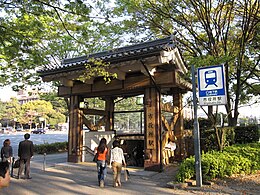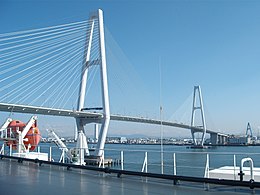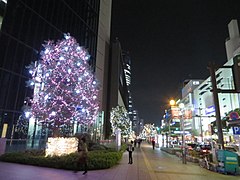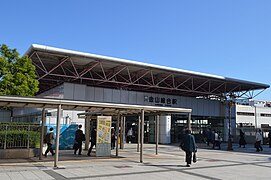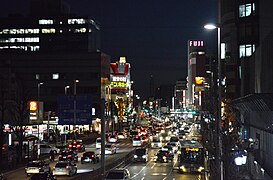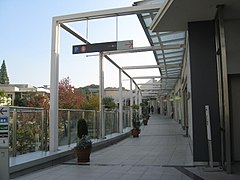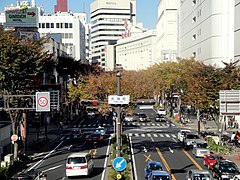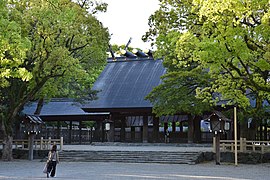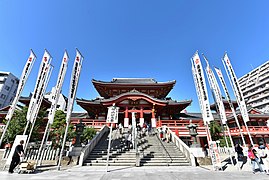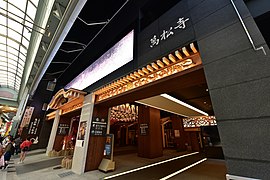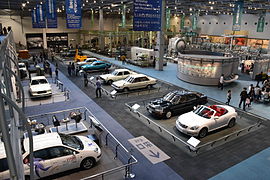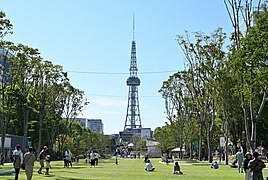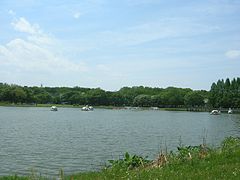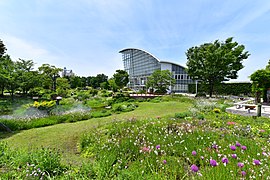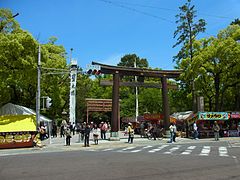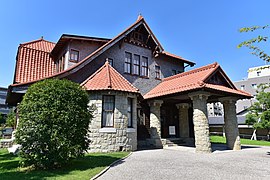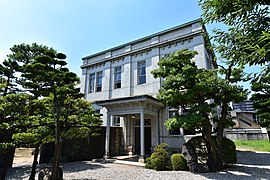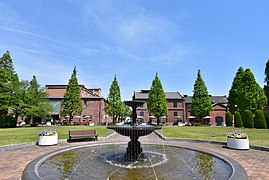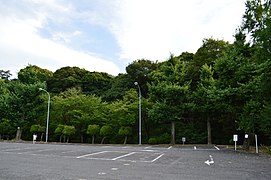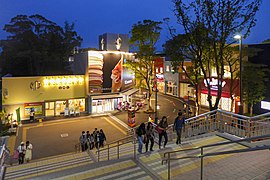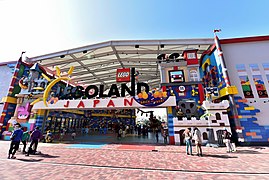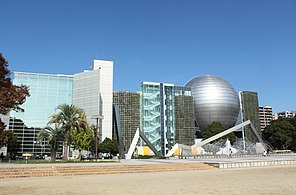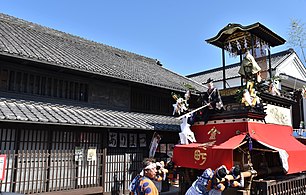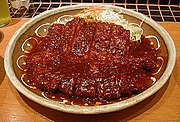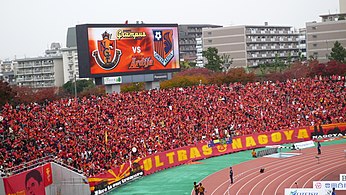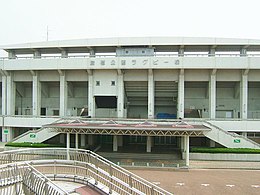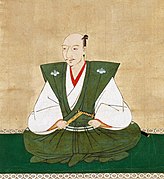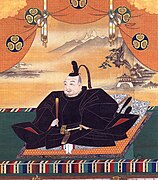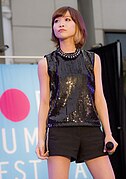|
Nagoya
Nagoya (名古屋市, Nagoya-shi, [naꜜɡoja] ⓘ) is the largest city in the Chūbu region of Japan. It is the fourth-most populous city in Japan, with a population of 2.3 million in 2020, and the principal city of the Chūkyō metropolitan area, which is the third-most populous metropolitan area in Japan with a population of 10.11 million.[3] Located on the Pacific coast in central Honshu, it is the capital and most populous city of Aichi Prefecture, with the Port of Nagoya being Japan's largest seaport. In 1610, the warlord Tokugawa Ieyasu, a retainer of Oda Nobunaga, moved the capital of Owari Province from Kiyosu to Nagoya. This period saw the renovation of Nagoya Castle. The arrival of the 20th century brought a convergence of economic factors that fueled rapid growth in Nagoya during the Meiji Restoration, and it became a major industrial hub for Japan. The traditional manufactures of timepieces, bicycles, and sewing machines were followed by the production of special steels, ceramic, chemicals, oil, and petrochemicals, as the area's automobile, aviation, and shipbuilding industries flourished.[4] These factors made the city a target for air raids during the Pacific War. Following the war, Nagoya's economy diversified, but the city remains a significant centre for industry and transport in Japan. It is linked with Tokyo, Kyōto, and Osaka by the Tokaido Shinkansen, and is home to the Nagoya Stock Exchange as well as the headquarters of Brother Industries, Ibanez, Lexus, and Toyota Tsusho, among others. Nagoya is home of educational institutes such as Nagoya University, the Nagoya Institute of Technology, and Nagoya City University. Famous landmarks in the city include Atsuta Shrine, Higashiyama Zoo and Botanical Gardens, Port of Nagoya Public Aquarium, Nagoya Castle, Hisaya Ōdori Park, and Nagoya TV Tower, one of the oldest TV towers in Japan. It will be the third Japanese city to host the 2026 Asian Games, after Tokyo 1958 and Hiroshima 1994. ToponymyThe city's name was historically written as 那古野 or 名護屋 (both read as Nagoya). One possible origin is the adjective nagoyaka (和やか), meaning 'calm'.[5] The name Chūkyō (中京), consisting of chū (middle) + kyō (capital) is also used to refer to Nagoya. Notable examples of the use of the name Chūkyō include the Chūkyō Industrial Area, Chūkyō Metropolitan Area, Chūkyō Television Broadcasting, Chukyo University and the Chukyo Racecourse. HistoryOrigins
In the Jomon and Yayoi period, the Ōguruwa Shell Midden was discovered before the settlement of Nagoya.
In the Kofun period, Nagoya was settled and the Danpusan Kofun and Shiratori Kofun was built in this area. The Atsuta Shrine is of ancient origin, it is home to the Imperial Regalia of Japan, the legendary sword Kusanagi no Tsurugi. According to traditional sources, Yamato Takeru died in 113 AD. The possessions of the dead prince were gathered together along with the sword Kusanagi; and his widow venerated his memory in a shrine at her home.
The Seigan-ji was built by the Fujiwara clan in the late Heian period. A member served as the head priest of the nearby Atsuta Shrine, one of the legendary shrines of Japan. It is believed that Yura-Gozen, also known as Urahime, a daughter of Fujiwara no Suenori, was married to Minamoto no Yoshitomo (1123–60) and their son Minamoto no Yoritomo's birthplace is Nagoya, he is also the founder of the Kamakura shogunate.
Feudal period
Oda Nobunaga and his protégés Toyotomi Hideyoshi and Tokugawa Ieyasu were powerful warlords based in the Nagoya area who gradually succeeded in unifying Japan. In 1610, Tokugawa Ieyasu moved the capital of Owari Province from Kiyosu, about seven kilometers (4.3 miles) away, to a more strategic location in present-day Nagoya. In May–June 1560, the Battle of Okehazama took place in Dengakuhazama, Owari Province which was just outside of what would become Nagoya city. In this battle, Oda Nobunaga defeated Imagawa Yoshimoto and established himself as one of the leading warlords in the Sengoku period.[6]
Early modern periodDuring this period Nagoya Castle was constructed, built partly from materials taken from Kiyosu Castle. During the construction, the entire town around Kiyosu Castle, consisting of around 60,000 people, moved from Kiyosu to the newly planned town around Nagoya Castle.[7] Around the same time, the nearby ancient Atsuta Shrine was designated as a waystation, called Miya (the Shrine), on the important Tōkaidō road, which linked the two capitals of Kyoto and Edo (now Tokyo). A town developed around the temple to support travelers. The castle and shrine towns formed the city.
Modern period
During the Meiji Restoration Japan's provinces were restructured into prefectures and the government changed from family to bureaucratic rule. Nagoya was proclaimed a city on October 1, 1889, and designated a city on 1 September 1956, by government ordinance. Nagoya became an industrial hub for the region. Its economic sphere included the famous pottery towns of Tokoname, Tajimi and Seto, as well as Okazaki, one of the only places where gunpowder was produced under the shogunate. Other industries included cotton and complex mechanical dolls called karakuri ningyō.
Mitsubishi Aircraft Company was established in 1920 in Nagoya and became one of the largest aircraft manufacturers in Japan. The availability of space and the central location of the region and the well-established connectivity were some of the major factors that lead to the establishment of the aviation industry there.
Nagoya was the target of air raids during the Pacific War. The population of Nagoya at this time was estimated to be 1.5 million, fourth among Japanese cities and one of the three largest centers of the Japanese aircraft industry. It was estimated that 25% of its workers were engaged in aircraft production. Important Japanese aircraft targets (numbers 193, 194, 198, 2010, and 1729) were within the city itself, while others (notably 240 and 1833) were to the north of Kagamigahara. It was estimated that they produced between 40% and 50% of Japanese combat aircraft and engines, such as the vital Mitsubishi A6M Zero fighter. The Nagoya area also produced machine tools, bearings, railway equipment, metal alloys, tanks, motor vehicles and processed foods during the war. Air raids began on April 18, 1942, with an attack on a Mitsubishi Heavy Industries aircraft works, the Matsuhigecho oil warehouse, the Nagoya Castle military barracks and the Nagoya war industries plant.[8] The bombing continued through the spring of 1945, and included large-scale firebombing. Nagoya was the target of two of Bomber Command's attacks. These incendiary attacks, one by day and one by night, devastated 15.3 square kilometres (5.9 sq mi). The XXI Bomber Command established a new U.S. Army Air Force record with the greatest tonnage ever released on a single target in one mission—3,162 tons of incendiaries. It also destroyed or damaged twenty-eight of the numbered targets and raised the area burned to almost one-fourth of the entire city.[9][full citation needed] Nagoya Castle, which was being used as a military command post, was hit and mostly destroyed on May 14, 1945,[10] followed by the Yokkaichi bombing in June 1945. Reconstruction of the main building was completed in 1959. Later in the same year on July 26, 1945, the Enola Gay also dropped a conventional pumpkin bomb in the Yagoto area of Nagoya as part of a bombing raid in order to train for their mission to Hiroshima.[11] In 1959, the city was flooded and severely damaged by the Ise-wan Typhoon. Contemporary periodAfter the war the city was able to rebuild and take up its role again as one of the country's leading industrial and manufacturing centers, it became known as the "Houston and Montreal of the Orient". It also plays an increasing role in the meetings, incentives, conferencing, exhibitions (MICE) industry, hosting the Expo 2005 and the Nagoya Protocol conference in 2010.
Geography and administrative divisions GeographyNagoya lies north of Ise Bay on the Nōbi Plain. The city was built on low-level plateaus to ward off floodwaters. The plain is one of the nation's most fertile areas. The Kiso River flows to the west along the city border, and the Shōnai River comes from the northeast and turns south towards the bay at Nishi Ward. The human-made Hori River was constructed as a canal in 1610. It flows from north to south, as part of the Shōnai River system. The rivers allowed for trade with the hinterland. The Tempaku River feeds from a number of smaller river in the east, flows briefly south at Nonami and then west at Ōdaka into the bay. The city's location and its position in the centre of Japan allowed it to develop economically and politically.
ClimateNagoya has a humid subtropical climate (Köppen climate classification: Cfa) with hot, humid summers and cool winters. The summer is noticeably wetter than the winter, although rain falls throughout the year.
AreaWards Nagoya has 16 wards.
Demographics
 One of the earliest censuses, carried out in 1889, counted 157,496 residents. The population reached the 1 million mark in 1934 and as of December 2010 had an estimated population of 2,259,993 with a population density of 6,923 inhabitants per square kilometre (17,930/sq mi). Also as of December 2010[update] an estimated 1,019,859 households resided there—a significant increase from 153,370 at the end of the Pacific War in 1945.[13] The area is 326.45 square kilometres (126.04 sq mi). Its metropolitan area extends into the Mie and Gifu prefectures, with a total population of about 10 million people, surpassed only by Osaka and Tokyo. Surrounding municipalitiesPublic servicesPolice
Firefighting
Health care
Post office
Library
Playhouses and cultural facilities
Sister cities The Nagoya International Center promotes international exchange in the local community. It houses the U.S. Consulate Archived 2020-12-28 at the Wayback Machine on the 6th floor and the United Nations Centre for Regional Development (UNCRD) on the 7th floor. International
The sister city relationship with Nanjing, China was suspended on February 21, 2012,[16] following public comments by Nagoya mayor Takashi Kawamura denying the Nanjing Massacre.[17]
National
Sister airportNagoya Airfield's sister airport is:
Economy 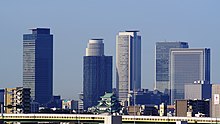       Nagoya is the center of Greater Nagoya, which earned nearly 70 percent of Japan's 2003 trade surplus.[20] Automotive industryNagoya's main industry is automotive. Toyota's luxury brand Lexus, Denso, Aisin Seiki Co., Toyota Industries, JTEKT and Toyota Boshoku have their headquarters in or near Nagoya. Mitsubishi Motors has an R&D division in the suburb of Okazaki. Major component suppliers such as Magna International and PPG also have a strong presence here. Spark plug maker NGK and Nippon Sharyo, known for manufacturing rolling stock including the Shinkansen are headquartered there. Aviation industryThe aviation history has historically been of importance since the industrialization. During the Second World War the Mitsubishi A6M Zero fighter was constructed in Nagoya. The aviation tradition continues with Mitsubishi Aircraft Corporation headquartered in the Nagoya Airfield's terminal building in Komaki. The Mitsubishi Regional Jet (MRJ) aircraft is produced at a factory adjacent to the airport.[21] The MRJ is a partnership between majority owner Mitsubishi Heavy Industries and Toyota[22] with design assistance from Toyota affiliate Subaru Corporation, already a manufacturer of aircraft. It is the first airliner designed and produced in Japan since the NAMC YS-11 of the 1960s.[23][24] The MRJ's first flight was on November 11, 2015.[25][26] CeramicsJapanese pottery and porcelain has a long tradition due to suitable clay being available in Owari Province. Before and during the Edo period there were two main kilns in the region: Seto and Tokoname. In Nagoya Castle a type of oniwa-yaki (literally "garden ware") called Ofukei ware was produced by the feudal lord's court. Almost every feudal lord had his own oniwa-yaki, also to have gifts made. In the town itself Toyoraku ware and Sasashima ware Japanese tea utensils were made with refined tastes. Ofukei ware started under the first Owari lord Tokugawa Yoshinao and was interrupted once, but continued on until the end of the Edo period. It became widely known in Japan. The lord's taste in ceramics was also imitated by other Owari samurai, such as Hirasawa Kurō and Masaki Sōzaburō, who made their own pieces. Toyoraku ware continued on until the Taishō era under the 8th generation. Colourful pieces and gorgeous tea utensils were highly valued. Sasashima ware also experienced its heyday during this time. Colourful and soft ceramic items such as sake and tea utensils and objects were produced and intently collected. An early type of manufactured production was the blue-and-white Kawana ware. With the advent of industrialization during the Meiji era of the late 19th century, some export wares were produced. Industrial-scale export porcelain was made by old Noritake, also Nagoya E-tsuke (名古屋絵付) became popular.[27] Production of industrial ceramics continues to be an important economic factor with companies such as INAX, NGK, and NGK Insulators. Meetings, Incentives, Conferences, Exhibitions (MICE)The city has an increasing role in the meetings, incentives, conferencing, exhibitions (MICE) industry. It hosted in 1989 the World Design Expo (世界デザイン博覧会) for which the Nagoya Congress Center was constructed.[28] It hosted the Expo 2005 and the Nagoya Protocol conference in 2010, as well as the G20 Aichi-Nagoya Foreign Ministers' Meeting in November 2019, which was held at the Nagoya Kanko Hotel and Kawabun.[29][30] TechnologyMechanized puppets, called "karakuri ningyō", are a traditional craft from the area. Robot technology is another rapidly developing industry. A materials engineering industry is developing.[31] Brother Industries, which is known for office electronics such as multifunction printers is based in Nagoya, as is Hoshizaki Electric, which is known for commercial ice machines and refrigeration equipment. Many small machine tool and electronics companies are also based in the area.[32] The World Expo 2005, also known as Aichi Expo was held near Nagoya in the neighboring cities of Nagakute and Seto from March 25 to September 25, 2005. RetailRetail is of importance in the city. Traditional department stores with roots in Nagoya are Matsuzakaya, Maruei and the Meitetsu Department Store. Oriental Nakamura was bought by Mitsukoshi from Tokyo in 1977. Arts and craftsThe Owari province was historically well known for the cloisonné art form. The Ando Cloisonné Company continues the long tradition. OthersThe confectionery company Marukawa is well known. The city offers venues for conferences and congresses such as the Nagoya Congress Center and the Nagoya International Exhibition Hall. Education   Nagoya has mostly state-run primary and secondary schools. The area in the city limits includes international schools such as the Nagoya International School and Colégio Brasil Japão Prof. Shinoda Brazilian school.[33] UniversitiesState and private colleges and universities primarily located in the eastern area. Some Western-style institutions were founded early in the Meiji era, with more opening during the Taishō and Shōwa eras. Nagoya University was set up in 1871 as a medical school and has produced seven Nobel Prize laureates in science.[34] Nanzan University was established by the Roman Catholic Society of the Divine Word in 1932 as a high school and expanded to include Nanzan Junior College and the Nanzan Institute for Religion and Culture. The main campus was designed in the 1960s by the renowned architect Antonin Raymond. Some universities specialise in engineering and technology, such as Nagoya University Engineering school, Nagoya Institute of Technology and Toyota Technological Institute; these universities receive support and grants from companies such as Toyota. Other colleges and universities include: Aichi Prefectural College of Nursing & Health, Aichi Shukutoku Junior College, Aichi Toho University, Chukyo University, Daido University, Doho University, Kinjo Gakuin University, Kinjo Gakuin University Junior College, Meijo University, Nagoya City University, Nagoya College of Music, Nagoya Future Culture College, Nagoya Gakuin University, Nagoya Management Junior College, Nagoya Women's University, St. Mary's College, Nagoya, Sugiyama Jogakuen University, Sugiyama Jogakuen University Junior College, Tokai Gakuen Women's College. Various universities from outside Nagoya have set up satellite campuses, such as Tokyo University of Social Welfare. The Hōsa Library dates to the 17th century and houses 110,000 items, including books of classic literature such as historic editions of The Tale of Genji that are an heirloom of the Owari Tokugawa and were bequeathed to the city. The Nagoya City Archives store a large collection of documents and books. Tsuruma Central Library is a public library and Nagoya International Center has a collection of foreign-language books.
Transport  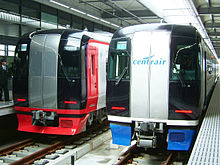     AirwaysAirportNagoya is served by Chubu Centrair International Airport (NGO), built on an artificial island in Tokoname. The airport has international flights and a high volume of domestic flights. A second airport is Nagoya Airfield (Komaki Airport, NKM) near the city's boundary with Komaki and Kasugai. On February 17, 2005, Nagoya Airport's commercial international flights moved to Centrair Airport. Nagoya Airfield is now used for general aviation and as an airbase and is the main Fuji Dream Airlines hub. RailwaysNagoya Station, the world's largest train station by floor area, is on the Tōkaidō Shinkansen line, the Tōkaidō Main Line, and the Chūō Main Line, among others. JR Central, which operates the Tōkaidō Shinkansen, has its headquarters there. Meitetsu is also based in Nagoya, and along with Kintetsu provides regional rail service to the Tōkai and Kansai regions. High-speed rail
Conventional linesSubwaysNagoya Subway provides urban transit service. BusesSeveral private and public bus companies operate with of routes throughout the region. Most local bus routes complement existing rail service to form an effective intermodal transit network. Roads Expressways
Japan National Route
SeawaysSeaportNagoya Port is the largest port by international trade value in Japan. Toyota Motor Corporation exports via this port. Nagoya is known for its orderly grid street plan for which the shōgun Tokugawa Ieyasu is ultimately responsible.[35]
Sightseeing Nagoya's two most famous sightseeing spots are Atsuta Shrine and Nagoya Castle.[36]
Other attractions include:
Gallery
Surrounding areaNagoya is a starting point for visits to the surrounding area, such as Inuyama, Little World Museum of Man, Meiji Mura, Tokoname, Himakajima, Tahara, Toyohashi and Toyokawa and Hamamatsu. Reachable with at most a two-hour journey are Gifu, Gujo Hachiman, Gifu, Ise Shrine, Takayama, Gifu, Gero Onsen and the hill stations in the Kiso Valley Magome and Tsumago. Culture
Nagoya was a major trading city and political seat of the Owari lords, the most important house of the Tokugawa clan. They encouraged trade and the arts under their patronage, especially Tokugawa Muneharu, the 7th lord, who took a keen interest in drama and plays and lived lavishly. Under his rule, actors and actresses began to visit Nagoya. Arts and culture was further supported by the city's wealthy merchants. Culture flourished after the feudal Edo period and the beginning of the Meiji era. During the Pacific War many old buildings and artefacts were destroyed. The region's economic and financial power in the post-war years rekindled the artistic and cultural scene.
MuseumsNagoya has multiple museums, including traditional and modern art, handicrafts to industrial high-tech, natural and scientific museums. Nagoya Castle's collection is from the Owari Tokugawa era. The main tower is a museum that details the history of the castle and the city. The Honmaru Palace, destroyed in the Pacific War, was reconstructed in 2018;[40] it is a prime example of the Shoin-zukuri architecture of the feudal era. Tokugawa Art Museum is a private museum belonging to the Owari Tokugawa, who lived in Nagoya castle for 16 generations. Among other things, it contains 10 designated national Treasures of Japan, including some of the oldest scrolls of The Tale of Genji.[41] The Nagoya Noh Theatre houses various precious objects of Noh theatre. The Nagoya City Museum showcases the history of the town. Yōki-sō is a villa and gardens located in Chikusa-ku, close to Nittai-ji. It was constructed in the Taishō era for Ito Jirozaemon Suketami XV, the first president of Matsuzakaya. Paintings and sculpture are exhibited at the Nagoya City Art Museum. Modern art is displayed at the Aichi Arts Center. The Aichi Arts Center also is the venue of rotating exhibitions. The art of porcelain and ceramics can be seen at the Noritake Garden. Toyota has two museums in the city, the Toyota Automobile Museum which shows vintage cars, and the Toyota Commemorative Museum of Industry and Technology, which showcases company history, including its start as a textile mill. The Nagoya City Tram & Subway Museum has trams and subway cars, as well as the Nagoya City Science Museum. The SCMaglev and Railway Park opened in March 2011 with various trains from the Central Japan Railway Company. Other art museums in Aichi prefecture are the Aichi Prefectural Ceramic Museum and the Toyota Municipal Museum of Art. Meiji Mura is an open-air museum with salvaged buildings from the Meiji, Taishō and Showa eras. Another museum in Nagoya is the Mandolin Melodies Museum. Other museums in the city include the International Design Centre Nagoya, the Japan Spinning Top Museum and the Bank of Tokyo-Mitsubishi UFJ Money Museum. The civic authorities promote tourism and have taken steps to safeguard architectural heritage by earmarking them as cultural assets. Apart from the castle, temples, shrines and museums in the city, a "Cultural Path" was instituted in the 1980s, located between the Tokugawa Art Museum and Nagoya Castle. This residential area has historic buildings such as the Nagoya City Archives, the Nagoya City Hall main building, the Aichi Prefectural Office main building, the Futaba Museum, the former residence of Sasuke Toyoda, the former residence of Tetsujiro Haruta and the Chikaramachi Catholic Church. Most buildings date from the Meiji and Taishō era and are protected. TheatresNō and Kyōgen theatre date back to the feudal times of the Owari Tokugawa lords. The Nagoya Noh Theater at Nagoya Castle continues that tradition and is a prominent feature in the cultural life of the city, with monthly performances. Developed during the Edo period, one of Japan's kabuki grand stages is Misono-za, which also hosts various other Japanese entertainment such as concerts. In 1912, the musician Gorō Morita invented the Nagoya harp music instrument. In 1992, the large, modern Aichi Arts Center was opened in Sakae. It is the main venue for performing arts, featuring a main hall that can be used for opera and theatre and a concert hall. The Nagoya Philharmonic Orchestra performs there, as well as many visiting guest orchestras. IkebanaIshida-ryū (石田流) is a school of Ikebana, or Japanese floral art. It was founded in 1922 and is headquartered in Nagoya. FestivalsApart from the main national festivals and holidays, other festivals in Nagoya are unique to the city/region. Major events include the June Atsuta Festival, the July Port Festival, the August Nagoya Castle Summer Festival Castle and the October Nagoya Festival. Wards and areas host local festivals such as the Daidō-chōnin Matsuri (大須大道町人祭, Street Performer's Festival) in Ōsu. DialectThe Nagoya dialect (名古屋弁, Nagoya-ben) is spoken in the western half of Aichi Prefecture, centering on Nagoya. It is also called Owari dialect (尾張弁, Owari-ben). The Nagoya dialect is relatively close to standard Japanese and to the Kansai dialect, differing in pronunciation and vocabulary. HandicraftsThe industry of Japanese handicrafts in the city is centuries old.
CuisineThe city and the region are known for their unique local Nagoya cuisine (名古屋めし, Nagoya meshi). Dishes include:
In popular cultureThe world premiere of the first Godzilla movie was in Nagoya on October 27, 1954.[47] The city, especially Nagoya Castle, has been featured in two other Godzilla movies: Mothra vs. Godzilla and Godzilla vs. Mothra. The city is also featured in Gamera vs. Gyaos and is the main setting of 2003 film Gozu. The 1995 film The Hunted starring Christopher Lambert and the 1992 film Mr. Baseball starring Tom Selleck were also filmed in the city. The city was the setting for the 2007 movie Ashita e no yuigon (translated as Best Wishes for Tomorrow), in which a Japanese war criminal sets out to take responsibility for the execution of U.S. airmen.[48] The anime The Wind Rises by Hayao Miyazaki, released in 2013, is a highly fictionalized biography of the Mitsubishi A6M Zero's chief engineer Jiro Horikoshi and takes mostly place in Nagoya of the 1920s and 1930s.[49][50] Nagoya is also the setting for the manga and anime series Yatogame-chan Kansatsu Nikki, which highlights many of the sites and traditions of the city. Haruki Murakami called Nagoya "another world" (異界, ikai) in the book "Tokyo Surume Club: Chikyuu no Hagurekata". Sports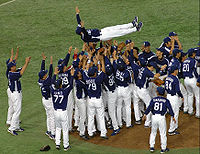
Nagoya is home to several professional sports teams:
In 2007, the Chunichi Dragons won the Japan Series baseball championship. In 2010, Nagoya Grampus won the J. League championship, their first in team history. Nagoya is also the home of the Nagoya Barbarians semi-pro rugby football club. A honbasho sumo tournament is held every July at the Aichi Prefectural Gymnasium. The city has hosted The Crowns golf tournament since 1960 and the women's Nagoya Marathon since 1984. In September 2016 the city was awarded the right to host the 2026 Asian Games after it was the only city to lodge a bid. It will be the third time Japan hosts the event after Tokyo in 1958 and Hiroshima in 1994.[51] The city had a bid to host the 1988 Summer Olympics but lost to Seoul. The city hosted the official 1979 Asian Basketball Championship. Later, it became one of the host cities of the official Women's Volleyball World Championship for its 1998, 2006 and 2010 editions.
Notable peopleHistorical figures Minamoto no Yoritomo was the first shōgun of the Kamakura shogunate. His family had roots as the high priests of Atsuta Shrine and he was born in the family villa what is Seigan-ji today. The three samurais who unified Japan in the 16th century all have strong links to Nagoya:
The three samurais who unified Japan in the 16th century Other samurai include:
Inventors and industrialists
Executive officersWriters
Scientists
Performing artists of JapanMusicians and composers
Musicians and composers Actors
Athletes
Manga artistsReferences
Bibliography
External linksWikimedia Commons has media related to 名古屋市. Wikivoyage has a travel guide for Nagoya. |
|||||||||||||||||||||||||||||||||||||||||||||||||||||||||||||||||||||||||||||||||||||||||||||||||||||||||||||||||||||||||||||||||||||||||||||||||||||||||||||||||||||||||||||||||||||||||||||||||||||||||||||||||||||||||||||||||||||||||||||||||||||||||||||||||||||||||||||||||||||||||||||||||||||||||||||||||||||||||||||||||||||||||||||||||||||||||||||||||||||||||||||||||||||||||||||||||||||||||||||||||||||||||||||||||||||||||||||||||||||||||||||||||||||||||||||||||||||||||||||||||||||||||||||||||||||||||||||||||||||||||||||||||||||||||||||||||||||||||||||||||||||||||||||||||||||||||||||||||












